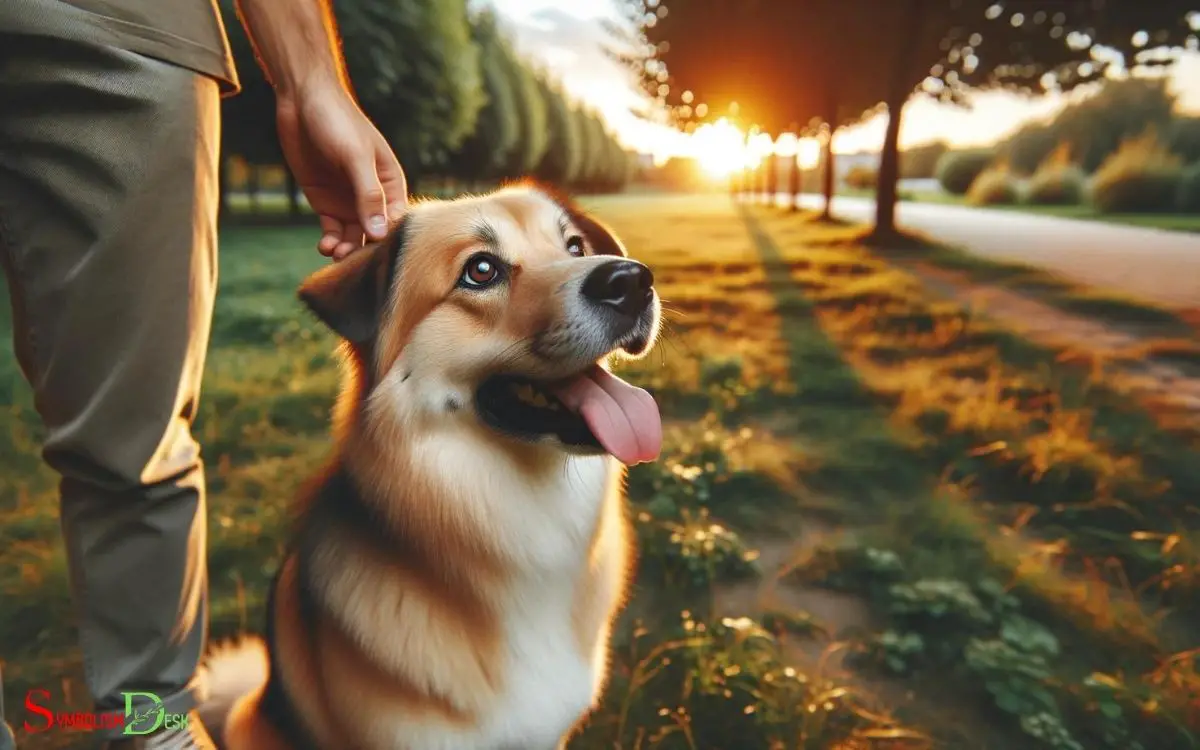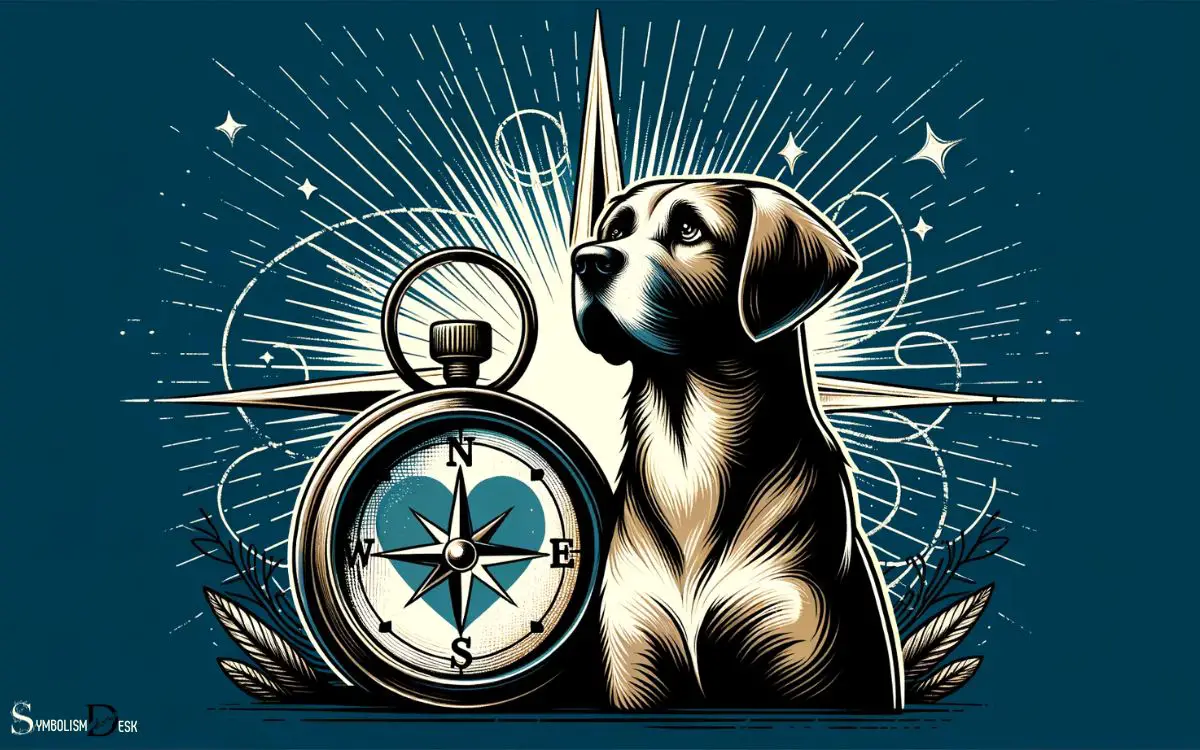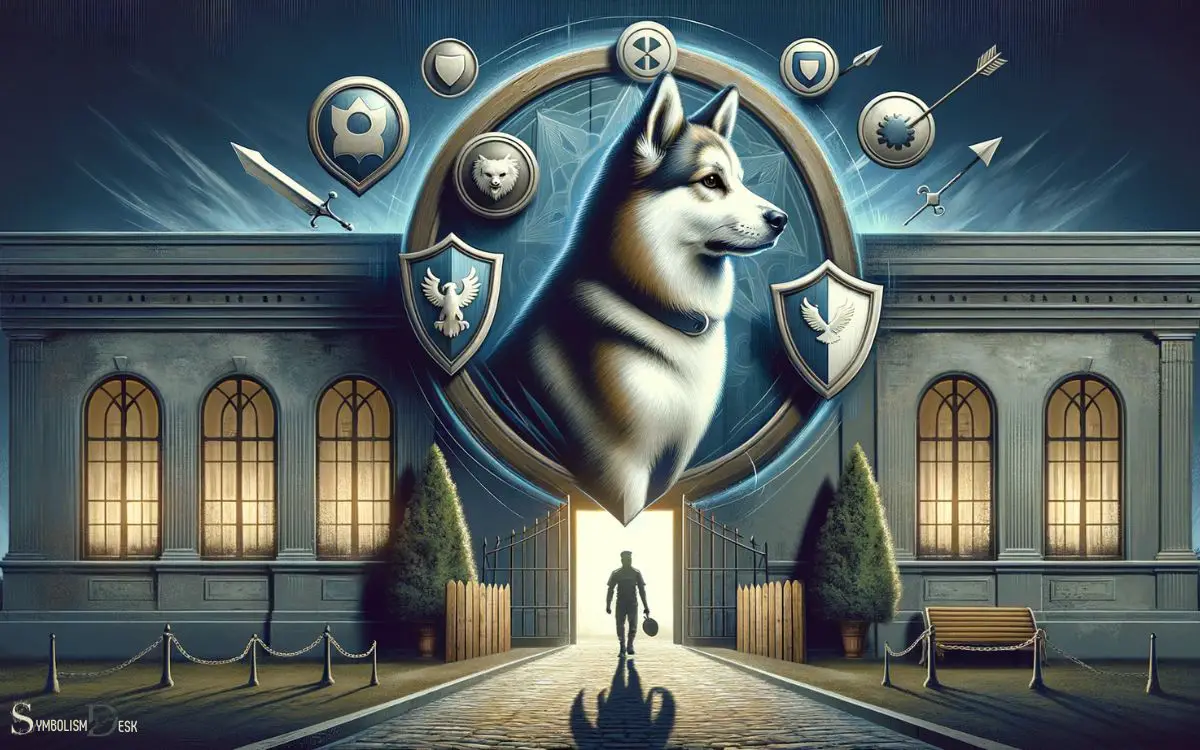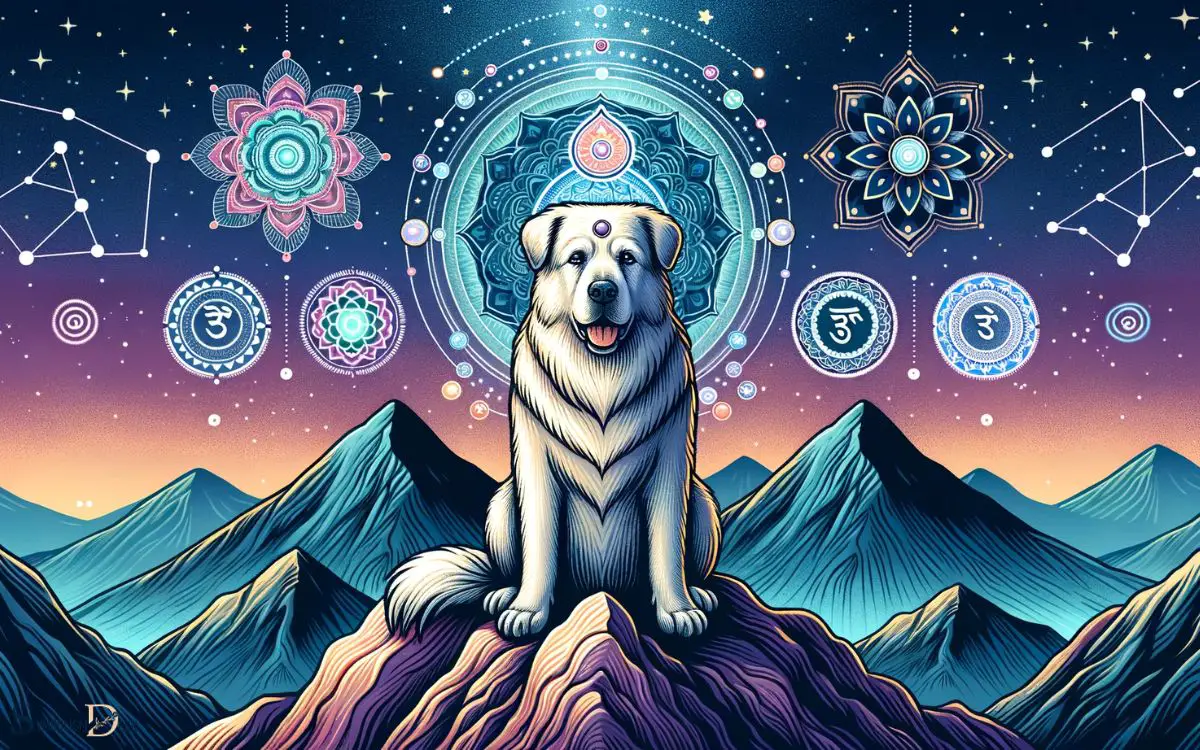What Is the Symbolic Meaning of a Dog? Protection!
The symbolic meaning of a dog encompasses loyalty, protection, and unconditional love. These animals have been represented as guides, guardians, and symbols of fidelity across various cultures and histories.
In spiritual contexts, dogs are often seen as bridge figures that lead souls to the afterlife or serve as protectors against evil spirits.
The dog, as a symbol, varies across different societies but commonly includes:
- Loyalty and Devotion: Dogs are known for their unwavering loyalty to their human companions.
- Protection: They are often associated with safeguarding homes and individuals.
- Service and Assistance: Dogs serve as helpers and support for people with disabilities.
- Spiritual Guides: In many mythologies, dogs guide souls to the afterlife.
- Vigilance: Their alertness makes them symbols of watchfulness.
For example, in ancient Egypt, the god Anubis, depicted with a canine head, is associated with mummification and the afterlife, embodying the protective and guiding qualities of dogs.
Dogs represent a multitude of virtues, from steadfast loyalty to vigilant guardianship, mirroring the depth of their bond with humans.

Key Takeaway
Historical Significance

While the symbolic meaning of a dog has evolved over time, its historical significance can be traced back to ancient civilizations.
Dogs were initially valued for their hunting and protective abilities. In ancient Egypt, they were revered as loyal companions and were even buried alongside their owners to guide them in the afterlife.
In Greek and Roman mythology, dogs were associated with various deities and were believed to possess healing powers. As civilizations progressed, dogs continued to hold significant roles. They were employed as guardians, hunters, and herders, playing crucial roles in daily life.
Over time, dogs became intertwined with human culture and were revered for their unwavering loyalty and companionship. Their historical significance paved the way for the deep emotional connection and symbolic meaning they hold in modern society.
Cultural Representations

Throughout history, dogs have been symbolically significant in various cultures, often playing a pivotal role in belief systems and societal practices.
The impact of dogs on cultural representations is a rich and diverse topic that highlights the deep connections between humans and these loyal animals.
Exploring the ways in which different cultures have incorporated dog symbolism provides valuable insights into the shared human experience and the reverence for these creatures.
Dog Symbolism in Cultures
Across various cultures throughout history, dogs have symbolized loyalty, protection, and companionship.
The symbolic meaning of dogs in different cultures includes:
- Ancient Egypt: Dogs were associated with the god Anubis, who was often depicted with the head of a jackal, symbolizing protection and guidance in the afterlife.
- Greek Mythology: Dogs were linked to the underworld and were believed to guide souls to the afterlife, making them symbols of transition and guardianship.
- Native American Cultures: Dogs were revered for their hunting abilities and seen as spiritual guides, representing loyalty and support.
- Chinese Culture: Dogs are one of the twelve zodiac animals and are associated with protection, loyalty, and auspiciousness in Chinese folklore.
Impact on Belief Systems
The symbolic representation of dogs has had a profound impact on various belief systems, shaping cultural perceptions and values.
In many cultures, dogs are revered for their loyalty, bravery, and protective instincts, leading to their symbolic association with qualities such as fidelity, vigilance, and guidance.
For example, in ancient Egyptian mythology, the god Anubis, often depicted with the head of a jackal or dog, was the guardian of the dead and the afterlife. In Norse mythology, dogs were associated with the guardian of the underworld.
These cultural representations have influenced beliefs about the afterlife, protection, and companionship.
Furthermore, in some cultures, dogs are considered unclean or dangerous, impacting societal attitudes towards these animals and shaping beliefs about purity and danger.
Mythological Interpretations

Mythological interpretations portray dogs as loyal companions and guardians in various cultures, symbolizing protection, loyalty, and guidance.
In mythology, dogs are often associated with specific traits and roles, such as:
- Guardians of the Underworld: In Greek mythology, dogs were believed to guide souls to the afterlife, making them symbols of guidance and protection in the transition between life and death.
- Divine Companions: In Norse mythology, the wolf Fenrir was accompanied by two faithful wolves, symbolizing loyalty and companionship even in the most challenging circumstances.
- Symbol of Protection: In ancient Egypt, the god Anubis was depicted with the head of a jackal, representing protection and guidance in the afterlife.
- Hunters and Protectors: Native American folklore often portrays dogs as hunters and protectors, symbolizing their role in providing for and safeguarding the community.
Literary Depictions
Numerous literary works feature dogs as loyal companions and symbols of unwavering devotion and fidelity. In ‘The Call of the Wild’ by Jack London, Buck, a powerful dog, symbolizes resilience and the innate wildness within all creatures.
Another notable example is ‘Old Yeller’ by Fred Gipson, where the bond between a boy and his dog reflects themes of love, loss, and coming of age.
Additionally, in ‘Where the Red Fern Grows’ by Wilson Rawls, the coonhounds Old Dan and Little Ann epitomize loyalty and perseverance as they accompany the protagonist on his adventures.
These literary depictions of dogs serve to highlight their unwavering loyalty and love, portraying them as more than mere pets, but as symbols of profound companionship and devotion.
Artistic Symbolism
Artistic symbolism often portrays dogs as a loyal companion, showcasing their unwavering devotion to their owners.
Additionally, in art, dogs are frequently depicted as symbols of protection, emphasizing their instinct to guard and watch over their human counterparts.
These artistic representations of dogs serve to convey the deep emotional connection and sense of security that they bring into people’s lives.
Dog as Loyal Companion
Symbolizing unwavering loyalty, the dog has been a beloved artistic symbol for centuries. Artists have often depicted dogs as loyal companions, emphasizing their faithfulness and devotion.
In art, the dog’s representation as a loyal companion carries deep symbolic meaning, resonating with viewers on a profound emotional level. This symbolism is evident in various artistic works, such as paintings, sculptures, and literature.
Here are some ways in which the dog is portrayed as a loyal companion in artistic symbolism:
1. Depicted standing faithfully by its owner’s side.
2. Shown in a protective stance, symbolizing its commitment to safeguarding its human counterpart.
3. Captured displaying affection and devotion, highlighting the emotional bond between human and canine.
4. Often depicted in religious art as a symbol of fidelity and unwavering loyalty.
Dog Representing Protection
The dog’s representation as a loyal companion seamlessly extends into its symbolic role as a protector in various forms of artistic expression.
In art, dogs are often depicted as guardians, symbolizing protection and loyalty. This is evident in ancient mythology, where dogs were seen as guides to the afterlife, protecting and guiding souls.
In paintings, sculptures, and literature, dogs are frequently portrayed as loyal protectors, standing by their owners in times of need. The image of a dog standing watch or barking at potential threats is a powerful symbol of vigilance and safeguarding.
This symbolism is also seen in modern art, where dogs are often used to represent security and protection. Whether it’s a faithful companion or a fierce guardian, the dog’s representation as a protector in art reflects its enduring symbolic significance.
Folklore and Traditions

In many cultures around the world, dogs have been regarded as companions and protectors, playing a significant role in folklore and traditions.
- Guardians: Dogs are often portrayed as guardians in folklore, protecting their owners from evil spirits and intruders.
- Guides to the Afterlife: Some traditions believe that dogs guide the souls of the deceased to the afterlife, serving as loyal companions even in death.
- Symbol of Loyalty: Many folklore and traditions depict dogs as symbols of loyalty and faithfulness, often exemplified through heroic acts or unwavering devotion.
- Healing Powers: In various cultures, dogs are associated with healing powers, believed to bring comfort and aid in recovery.
These traditional beliefs and stories showcase the deep-rooted significance of dogs in folklore and traditions, emphasizing their enduring presence in human history.
Do Dogs Also Symbolize Nobility?
Dogs are often considered loyal and noble creatures, embodying the symbolic meaning of peacock. Throughout history, dogs have been associated with royalty and nobility, serving as companions to kings and queens. Their unwavering loyalty and protective nature further solidify their symbolic connection to nobility.
Do Dogs Also Symbolize Freedom in Any Way?
Dogs can symbolize freedom in their loyalty and joyful spirit. They epitomize the carefree nature of running and playing. Similar to symbolic bird meanings, dogs can represent independence and fearlessness. Their ability to roam and explore embodies the spirit of freedom in a unique way.
Contemporary Symbolism
Dogs continue to hold a prominent role in contemporary symbolism, representing companionship, protection, and unwavering loyalty in modern society.
In today’s world, dogs are often used as symbols of emotional support and companionship, particularly in the realm of therapy and service animals. They’re also seen as symbols of protection, as evidenced by the use of guard dogs in security and law enforcement.
Additionally, dogs symbolize unwavering loyalty, as seen in the widespread use of the phrase ‘man’s best friend.’ In popular culture, dogs are frequently used to represent these qualities in literature, film, and advertising, further embedding their symbolism in modern society.
As such, the symbolic meaning of dogs continues to be relevant and deeply ingrained in contemporary culture.
Conclusion
The symbolic meaning of a dog is a complex and multifaceted concept that has evolved over time. From ancient cultures to modern society, dogs have been revered as loyal companions, protectors, and symbols of fidelity. Throughout history, dogs have also been associated with qualities such as bravery, intelligence, and instinctual wisdom. In some cultures, they are even seen as spiritual guides and guardians. In understanding rooster symbolism, one can appreciate the deep-rooted significance of dogs in human culture and the various roles they play in our lives.
Their representation in mythology, literature, and art reflects the deep connection between humans and these furry creatures. And let’s not forget the contemporary symbolism of dogs as Instagram influencers and emotional support animals.
Truly, the dog holds a special place in the hearts and minds of humanity.






